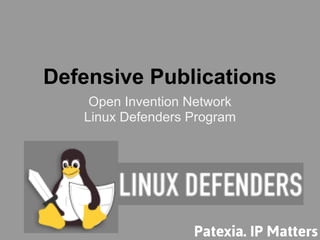Defensive Publication - Patexia IP Matters Webinar
- 1. Defensive Publications Open Invention Network Linux Defenders Program
- 2. Article 1 Section 8 Clause 8 "...Promote the progress of Science and useful Arts by securing for limited times to Authors and Inventors the exclusive Right to their respective Writings and Discoveries. "
- 4. Software patent grants Beginning with those granted pre-1991
- 5. Number of lawsuits filings involving software patents
- 6. Role of patent examiner â—Ź Determine whether applications comply with the basic format, rules and legal requirements â—Ź Determine the scope of the invention â—Ź Search for prior art â—Ź Issue office actions Over the life of the application, the patent examiner spends 20 maximum hours doing all of the above Peer To Patent First Pilot: Final Results
- 7. Challenges the Examiner Faces After all is said and done, the patent examiner only gets 7-8 hours to determine whether an application is worthy of a 20 year monopoly. Challenges: â—Ź Patent Backlog â—Ź Patent Legalise â—Ź Limited access to non-patent literature
- 8. Examples of prior art not typically searched by the patent office â—Ź Scientific Publications â—Ź Technical Reports (universities, companies) â—Ź Conference proceedings (scientific/ non- scientific) â—Ź Conference talks â—Ź Blog posts â—Ź Mailing list archives â—Ź Usenet posts â—Ź ...
- 9. Lawsuits filed by Non-Practicing Entities RPX Corporation
- 10. Limiting and Removing the Patent Threat There are three points in time where we can interfere: 1. Before a patent claim is submitted by an entity: Defensive Publication 2. During a patent examination: Pre-Grant Submissions. 3. Trying to invalidate a patent after it has been issued: Post issue
- 11. Innovation Options 1) Patent everything you create 2) Ignore patents and cross your fingers that no one sues 3) Actively protect your work
- 12. What is a Defensive Publication? A publication that serves as explicit prior art and ensures freedom to operate around your design. â—Ź They are a powerful way to prevent bad software patents from getting issued. â—Ź Give the patent examiner insight as to the state of technology.
- 13. Healthy Innovation Defensive Publications allow us to disrupt the balance of the construct of the patent system Approach: Patents are awarded if New and Not Obvious â—Ź If there is no prior art then the patent will be awarded. Creating prior art destroys the possibility for the claimed invention to be patented.
- 14. How to write a defensive publication? Writing a defensive publication is simple: â—Ź Title â—Ź One to two pages of text (at minimum) describing HOW the idea works: â—‹ Introduction â—‹ A description of what is currently available and of your idea â—‹ The steps involved â—Ź A figure describing the interaction between components Most important is explaining HOW this would work.
- 15. Example of a defensive publication
- 16. Who writes Defensive Publications? Many entities publish defensive publications: IBM The Internet Society (namely the IETF's Requests for Comments) Cisco Microsoft Lenovo NIST Motorola Siemens Nokia Sony Xerox Individuals
- 17. When to write a defensive publication? â—Ź Whenever you come up with an idea that makes you enthusiastic â—Ź It does not matter if you implemented or not If you want to blog about it and tell your friends in the middle of the night about your idea, that is the right time.
- 18. How is Linux Defenders Involved? Submitting defensive publications through Linux Defenders ensures that the patent examiner will gain access to these. Process: â—Ź Submit on linuxdefenders.org â—Ź Each defensive publication gets posted on IP.com â—Ź IP.com is a digital notary â—Ź Patent examiners use IP.com when conducting prior art searches.
- 19. Questions? Contact me! acasillas@openinventionnetwork.com Thank you!
- 20. References RPX Corporation, Tracking Patent Activity: A Post Script to the DOJ Report (March 2013) http://www.rpxcorp.com/index.cfm?pageid=14&itemid=29 Peer To Patent, First Pilot: Final Results (2012). http://dl.dropbox.com/u/2541719/First%20Pilot%20Final% 20Results.pdf





















